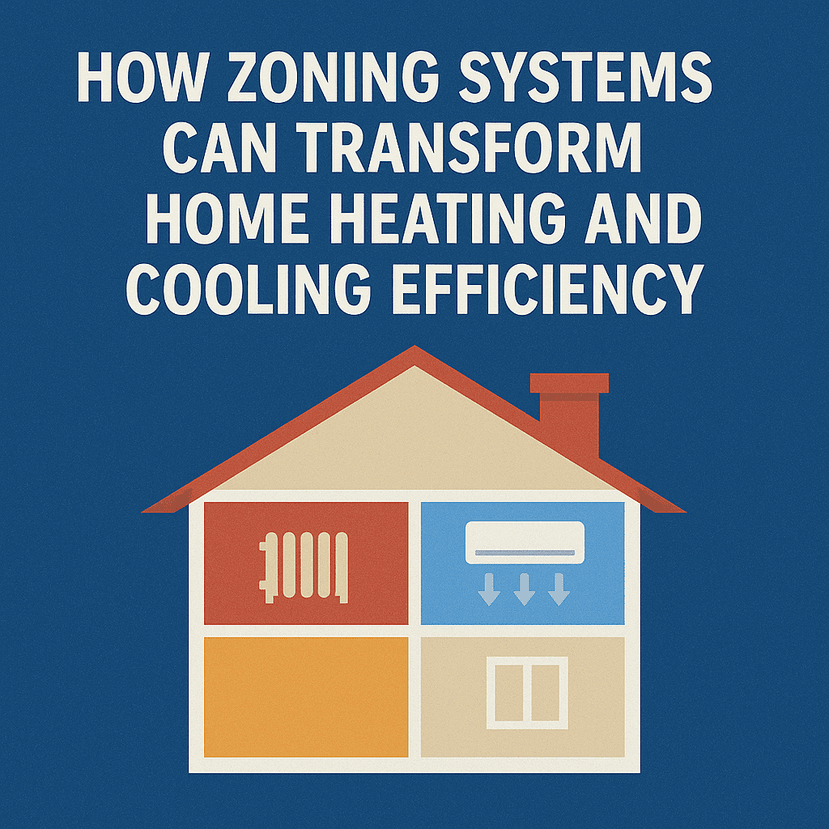Homeowners across the country are searching for smarter ways to enhance indoor comfort while reducing energy bills. One of the most powerful yet underutilized methods is the integration of HVAC zoning systems. When designed and implemented properly, multi-zone HVAC solutions can significantly elevate heating and cooling efficiency, extend system life, and provide customized comfort in every corner of the house.
What is an HVAC Zoning System?
An HVAC zoning system divides a home into separate zones, each with its own thermostat and airflow control, allowing for independent temperature regulation. Instead of heating or cooling the entire house uniformly, zoning systems deliver conditioned air only to where it’s needed, when it’s needed. This method eliminates hot or cold spots and reduces unnecessary energy consumption in unused areas.
Key Components of a Zoning System
Implementing a high-performing multi-zone HVAC system requires several interconnected components working in harmony:
- Zone Dampers: Installed within the ductwork, these dampers open and close to control airflow to specific areas.
- Thermostats: Each zone has its own thermostat to detect temperature and send signals to the zone control panel.
- Zone Control Panel: The brain of the system that receives commands from thermostats and directs dampers accordingly.
- Variable Speed HVAC Units (optional but ideal): These units adjust output levels to meet specific zoning requirements efficiently.
Advantages of HVAC Zoning for Modern Homes
1. Unmatched Energy Efficiency
The most impactful benefit of zoning is its potential to reduce energy consumption. Traditional HVAC systems operate on a one-size-fits-all principle, heating or cooling every room whether it’s occupied or not. By tailoring temperature control per zone, energy waste is minimized, and monthly utility bills can drop significantly.
2. Enhanced Comfort for Every Room
Every home has areas with different thermal characteristics—sunrooms, basements, attics, bedrooms above the garage. With zoning, these variations are addressed independently, ensuring consistent comfort across all zones regardless of external weather conditions or room orientation.
3. Personalized Control
With smart thermostats integrated into each zone, occupants gain full control over their comfort. Whether it’s keeping the nursery warmer at night or the home gym cooler during the day, zoning makes customized living a reality.
4. Reduced Wear and Tear on Equipment
Running the HVAC system at full capacity to serve the entire home places unnecessary stress on the unit. Zoning allows targeted usage, decreasing the workload and extending the lifespan of the equipment. This means fewer repairs and replacements over time.
Multi-Zone HVAC: A Game-Changer for Larger Homes
For homeowners with larger properties or multi-story buildings, a single thermostat can’t accurately detect and regulate temperatures throughout the house. Multi-zone HVAC systems solve this problem elegantly, allowing for precise temperature management on a floor-by-floor or room-by-room basis.
This is particularly useful in:
- Two-story homes where heat naturally rises, creating a temperature imbalance.
- Open-concept floor plans that are difficult to regulate with a single zone.
- Homes with infrequent room use, like guest bedrooms or home offices.
Smart Thermostats and Zoning: The Perfect Pair
Integrating smart thermostats with zoning enhances automation and convenience. These intelligent devices allow remote control via smartphone, learn usage patterns, and adjust automatically based on occupancy and preferences.
Top features include:
- Geofencing: Adjusts the temperature based on whether anyone is home.
- Learning algorithms: Learns the schedule of each zone for automatic adjustment.
- Energy reports: Tracks usage to help identify savings opportunities.
Pairing smart thermostats with zoning systems provides an intuitive and optimized climate control experience.
Energy Efficiency Upgrades That Complement HVAC Zoning
To maximize the benefits of a zoning system, consider these complementary energy efficiency upgrades:
1. High-Efficiency HVAC Units
Replacing older systems with ENERGY STAR® rated models improves efficiency and works seamlessly with zoning components.
2. Duct Sealing and Insulation
Even the most advanced zoning system can underperform if ducts are leaky or uninsulated. Sealing and insulating your ductwork ensures minimal energy loss and maximum performance.
3. Smart Home Integration
Sync zoning systems with smart home platforms like Google Home or Alexa for voice control, automation, and integration with lighting, blinds, and occupancy sensors.
Is Zoning Right for Every Home?
While zoning is incredibly beneficial, it’s not a one-size-fits-all solution. Here’s when you should consider HVAC zoning:
- You experience hot or cold spots in your home.
- Your house has multiple floors or wings.
- You’ve added extensions or finished basements/attics.
- Family members prefer different temperature settings.
- You want to optimize energy usage and cut monthly costs.
Consulting with a certified HVAC contractor can determine whether retrofitting your existing system or installing zoning in a new build is feasible.
Installation and Cost Considerations
The cost of installing a zoning system depends on:
- Number of zones required
- Complexity of ductwork
- Type of HVAC equipment in use
- Integration with smart controls
While the initial investment may be higher than a standard system, the long-term energy savings, improved comfort, and equipment longevity often offset the cost within a few years.
Why Zoning is the Future of HVAC Systems
As homeowners increasingly seek sustainable and efficient solutions, HVAC zoning stands out as an intelligent upgrade. The ability to control temperature room-by-room not only enhances comfort but plays a significant role in reducing your carbon footprint and maximizing HVAC performance.
When integrated with modern smart home ecosystems, the zoning system transforms from a luxury to a necessity in energy-conscious homes.
Final Thoughts
HVAC zoning systems offer a transformative approach to residential comfort and energy efficiency. With rising energy costs and growing interest in smart home technology, zoning is no longer a niche feature—it’s becoming a mainstay in modern HVAC design.
Whether you’re building a new home or upgrading an existing one, zoning provides the perfect blend of comfort, control, and cost-efficiency.
If you’re ready to explore zoning solutions, consult with a professional HVAC specialist and unlock the full potential of your home’s heating and cooling system.


